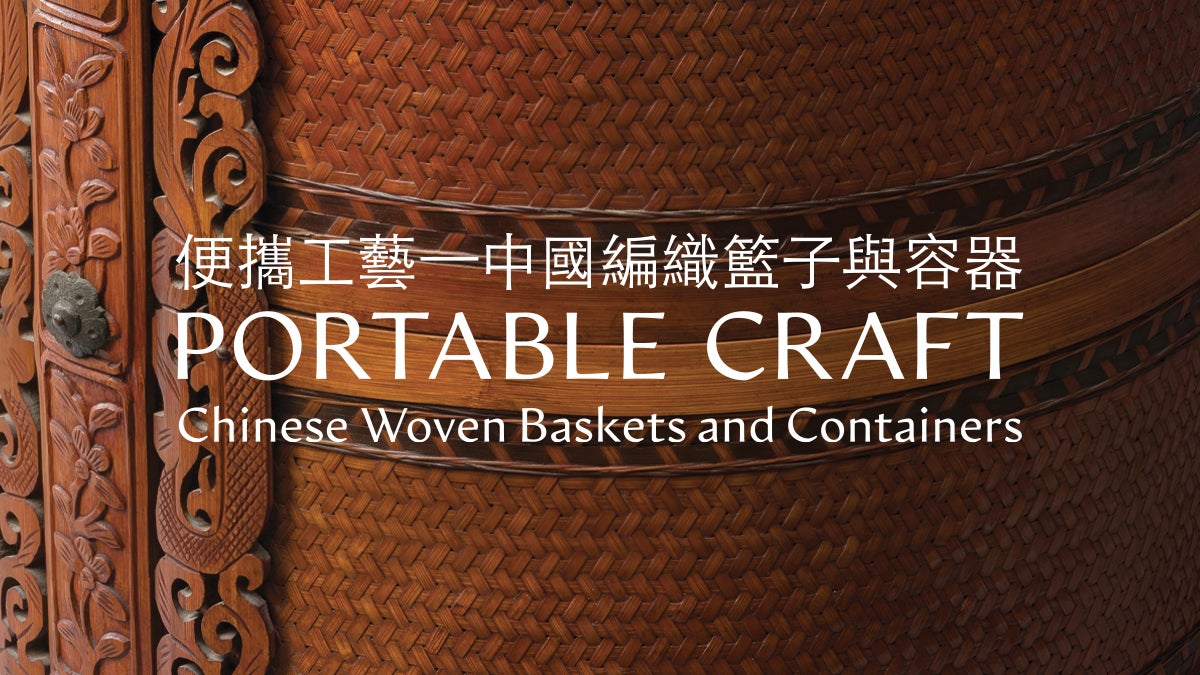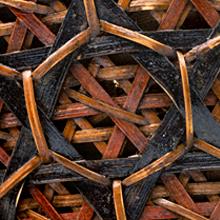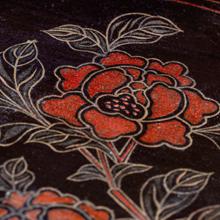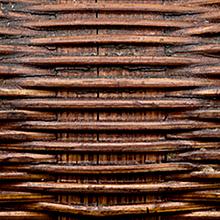Portable Craft: Chinese Woven Baskets and Containers
便攜工藝 — 中國編織籃子與容器
Portable Craft: Chinese Woven Baskets and Containers
One of the earliest crafts known to humankind, the near-universal art of basketmaking has developed globally by using locally available plant materials. Unlike pottery, the oldest examples have long since decomposed. In China, evidence for basketry appears as impressions on earthenware vessels dating to the Neolithic period (7000–1700 BCE). Since then, Chinese craftspeople have split and woven bamboo, reeds, and willow to craft various types of containers for everyday use. Weaving methods entail techniques such as plaiting: weaving over and under using a variety of sequences to create different patterns. Baskets in the north appear sturdy, practical, and simply decorated; while in central and southern China, basketry is often exquisitely embellished with materials such as wood, metal, and lacquer—another traditional Chinese art form. The application of lacquer to basketry may date to the Eastern Han dynasty (25–220 CE). Chinese lacquer is made from the sap of a tree species native to southern China, which is applied as a protective and ornamental finish.
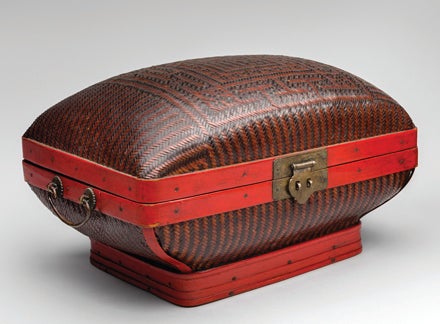 Baskets range in size, form, and usage—from sewing baskets and hat containers to food-carrying baskets and storage containers for grain, clothing, and a host of other domestic items. For centuries, kitchens were located a distance from the dining and living quarters to keep smoke and heat at bay. Food baskets kept meals warm in transit from the kitchen to the dining room. They also allowed farmers to easily transport food to the fields. Many baskets serve multiple functions; for instance, a basketry lid may double as a rice bowl. Betrothal or gift baskets, some of the most ornate Chinese baskets, are filled with food and gifts and given to the bride-to-be by the groom and his family.
Baskets range in size, form, and usage—from sewing baskets and hat containers to food-carrying baskets and storage containers for grain, clothing, and a host of other domestic items. For centuries, kitchens were located a distance from the dining and living quarters to keep smoke and heat at bay. Food baskets kept meals warm in transit from the kitchen to the dining room. They also allowed farmers to easily transport food to the fields. Many baskets serve multiple functions; for instance, a basketry lid may double as a rice bowl. Betrothal or gift baskets, some of the most ornate Chinese baskets, are filled with food and gifts and given to the bride-to-be by the groom and his family.
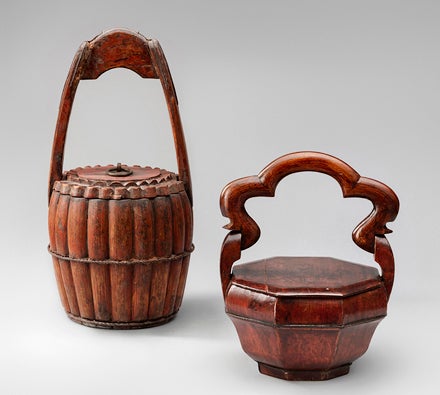 Although mass-produced plastic containers are now ubiquitous, in parts of rural China, handwoven bamboo baskets still take precedence, particularly in southwest China where they appear in a variety of forms: from rice storage containers to woven backpacks and baby carriers. Betrothal baskets are still made today in several southeastern provinces, many now intended for the tourist or international market. The late 19th– to early 20th–century basketry on display celebrates the exceptional artistry of this Chinese craft. Many of them feature hand-painted motifs and auspicious symbols. Some of the “baskets” in this exhibition are not woven at all; rather they are entirely crafted from wood and lacquered, mimicking the form of a basket, while demonstrating the ingenuity of Chinese carrying containers.
Although mass-produced plastic containers are now ubiquitous, in parts of rural China, handwoven bamboo baskets still take precedence, particularly in southwest China where they appear in a variety of forms: from rice storage containers to woven backpacks and baby carriers. Betrothal baskets are still made today in several southeastern provinces, many now intended for the tourist or international market. The late 19th– to early 20th–century basketry on display celebrates the exceptional artistry of this Chinese craft. Many of them feature hand-painted motifs and auspicious symbols. Some of the “baskets” in this exhibition are not woven at all; rather they are entirely crafted from wood and lacquered, mimicking the form of a basket, while demonstrating the ingenuity of Chinese carrying containers.
Special thank you to Sally Yu Leung for making this exhibition possible and to Dr. William Ma, Assistant Professor, College of Art & Design, Louisiana State University, for his curatorial contributions.
@SFOMuseum
#ChineseBasketry
[image top]
竹編箱子
Storage box 1900–30
possibly Shanxi Province, China
bamboo, wood, lacquer, metal
Collection of Sally Yu Leung
L2025.0401.003
[image bottom]
木提桶
Carrying containers late 19th–early 20th century
China
wood, lacquer, metal
Collection of Sally Yu Leung
L2025.0401.014a,b-.015a,b
© 2025 by San Francisco Airport Commission. All rights reserved.
